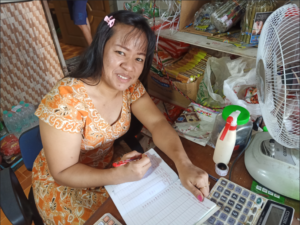 The grocery shop owner’s name is Daw Moe Moe Win Khaing, and her shop was established in May 2021. She also earns a second income by giving tailoring training services. However, the income generated by her tailoring lesson business is very limited. She lives with her two children, her husband, her mother, and her brother. Her husband is a laborer in the construction industry. The grocery shop is the main source of income for her family at present.
The grocery shop owner’s name is Daw Moe Moe Win Khaing, and her shop was established in May 2021. She also earns a second income by giving tailoring training services. However, the income generated by her tailoring lesson business is very limited. She lives with her two children, her husband, her mother, and her brother. Her husband is a laborer in the construction industry. The grocery shop is the main source of income for her family at present.
Looking back to the past years before the grocery shop started, the tailoring business was the main source of income. She opened the tailor shop about eight years ago, which was her main income and profession. The business was located in the same venue as her current house, they just separated a part of it into a workshop. There were many customers such as neighbors and random walk-ins, and promotion was from mouth-to-mouth. Even people from the other townships in Yangon, before COVID-19 happened, would come to her shop for tailoring. Unfortunately, due to the COVID-19 pandemic, there were fewer celebrations, parties, traveling, etc. and she lost many customers. She would have lost fewer customers if her workshop was located at the side of the main road, more visible to customers, but her business was located in the local ward area and was hidden from the people who tried to reach it during the pandemic. In the following months, she faced difficulty with daily household expenses, and her husband’s income was not sufficient either. Due to this, she had to think and look for other business ideas to earn enough money to survive. In the meantime, her nephew passed away in an accident, and her sister received compensation. As a result, she was able to get a loan from her sister, who lent her the money at a 3% interest rate for a month. With the money, she temporarily stopped the tailoring work and started the grocery shop.
She started the grocery shop during the COVID-19 pandemic, after the initial lockdowns. At that time, all the businesses were beginning to open and product sales were back to normal. The early pandemic difficulties in getting supplies from suppliers and bigger traders were gone. She supplies many types of grocery products and COVID-19 protections such as masks, face shields, hand sanitizers, gloves, etc. She also sells a few types of medicines (including local traditional medicine) that were in high demand by customers. Sometimes the suppliers are out of stock on products such as dried shrimp, fish sauce, salt, etc. This is not just because of COVID-19 but also because of transportation issues. The lack of these products from her regular supplier forces her to look for another supplier, which is time-consuming. In addition to this, prices have been fluctuating, especially for rice and kitchen oil. She thinks that the prices get lower when the farms’ products are of low quality due to weather, and they get higher when the farms’ products are not available during certain seasons. COVID-19 protection costs are also unstable, increasing only when a new COVID wave comes.
 She does all her transactions with cash only. She does not accept credit payments from customers because she doesn’t make much profit and her products have a reasonable price, the same as other competitors. However, she is flexible with those who have less income, especially those from the low-income area nearby. For customers from this area, she gives a very limited number of items on credit at the original price (the credit is for a maximum of one month) or sells to them at a discount price. she doesn’t have much income so she feels that she cannot make large donations, but she can do it in a way that at least makes her feel happy and allows these people to buy products with credit on their request. Those who do credit payments also feel that her shop allows them to take this opportunity and keep buying from her.
She does all her transactions with cash only. She does not accept credit payments from customers because she doesn’t make much profit and her products have a reasonable price, the same as other competitors. However, she is flexible with those who have less income, especially those from the low-income area nearby. For customers from this area, she gives a very limited number of items on credit at the original price (the credit is for a maximum of one month) or sells to them at a discount price. she doesn’t have much income so she feels that she cannot make large donations, but she can do it in a way that at least makes her feel happy and allows these people to buy products with credit on their request. Those who do credit payments also feel that her shop allows them to take this opportunity and keep buying from her.
In her situation, she is not impacted by the extremity of the COVID-19 waves or their lockdowns because the demand for her products is not impacted, nor is the price. This is because most of her customers are from the same ward area and nearby. On the other hand, the customers cannot make an effort to supply everything at once. Normally, she opens at 6.30 am and closes at 9 pm, but she had to change the closing hours to 8 pm during lockdown. Since her shop is located next to her house, she is less worried about traveling to and from her shop. Another reason the lockdown had little effect on her business is that her neighbors and regular customers are unable to go to other shops, and her shop is handily located nearby. However, she didn’t increase the price of her products so her net profit was the same.
This shop is her main source of income and she intends to continue running it. She also intends to extend her stock beyond what she already has. She is willing to stock more because the demand is getting higher and, in the first week of the month, she is getting double the normal sales due to the customers getting paid at the end of the previous month. She wants to invest in the business to save money on transportation. She already has travel expenses for purchasing rice, which is not accessible in her area, and it costs more if she has to buy small amounts repeatedly. For example, she had to buy a bag of rice every week. Instead, if she could save money and buy four bags of rice at once, she would save money on transportation. But as it is, she has been unable to increase her rice investment, and she continues to be charged for her travel expenses. However, she does not spend travel costs on other things because she travels by bicycle. She started using an application called ZegoDealer Online Wholesale App where she can buy foods, groceries, beverages, personal and baby care items, etc. Moreover, the price of products on the application is also reasonable and sometimes cheaper than the market price. The ZegoDealer delivers at her shop.
Currently, the main challenge that she is facing is from a new competitor who has opened a grocery stop around her location. She observed that the competitor was also observing her sales price through her customers and was selling products at the same price as hers. Therefore, she is forced to lower the price more than others and this is impacting her business income and her profit is decreasing more than before. The demand has not changed, but her profit has decreased. All things considered, she has to learn more about her competitors and figure out the best way to fight.
Written by Theresa Natolay

